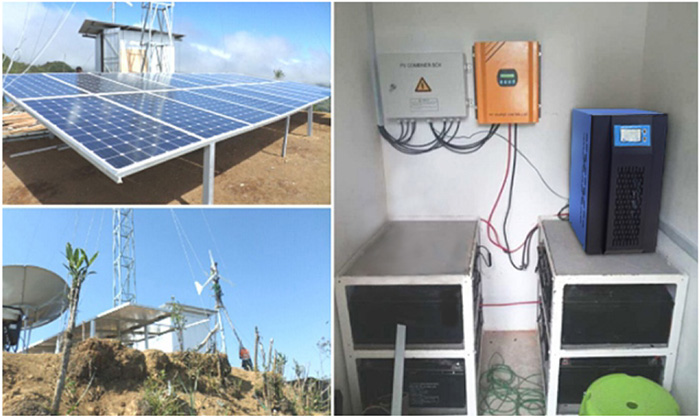
Telephone / WhatsApp:
+86 18924874907

Hybrid Solar Inverter Charger Manufacturer
○16-year experience ○Factory wholesale ○OEM/ODM
Welcome to the website of Guangdong Xindun Power Technology Co.,Ltd.
PRODUCTS
Guangdong Xindun Power Technology Co.,Ltd.
|
Details
Position:
Home>
Details
Change from grid-tie system to off-grid system
Date: 2019-07-04
Click: 4760
There are two typical applications of photovoltaic, grid-connected system and off-grid system.
There are two typical applications of photovoltaic, grid-connected system and off-grid system. The grid-connected system relies on the power grid, and adopts the working mode of "self-service, surplus power access to the grid" or "full access to the grid". The off-grid system does not depend on the power grid, but on the working mode of "storing while using" or "storing before using". For families in areas without power grids or with frequent blackouts, the off-grid system has strong practicability. 1. Off-grid system can not calculate return on investment When we invest money in real estate, stocks, industry and other projects, we have to calculate how much money we can make each year and how many years we can get back the capital. There is a state subsidy for grid-tied power generation, and the construction of power plants is an investment behavior. The most important concern of customers is the rate of return on investment. But if we buy a mobile phone, computer, clothes and other necessities of life, we will not calculate how many years we can earn the cost back, and so will the off-grid system. Why can't the off-grid system economically calculate the grid-tied system, because the cost of off-grid system is much higher than grid-tied system.
2. High Cost of Off-grid System The off-grid system consists of photovoltaic array, solar controller, inverters, batteries and loads. Compared with grid-tied system, there are more batteries, accounting for 30-40% of the cost of power generation system, and almost the same components. Moreover, the service life of the battery is not long, lead-acid batteries are generally in 3-5 years, and lithium batteries are generally in 8-10 years. The cost of off-grid inverters is 1.5 to 3 times higher than grid-tied inverters. The structure of off-grid inverters is more complex than grid-tied inverters. The grid-tied inverters are generally two-stage structure of boost and inverters. The off-grid inverters generally have four-stage structure, including controller, boost, inverters and isolation. The cost of off-grid inverters is about 2 times grid-tied inverters. With the same power, the overload capacity of off-grid inverters is more than 30% higher than grid-tied inverters. The front-end components of grid-tied inverters, whose output is connected to the grid, generally do not need overload capacity, because few components have output power greater than the rated power. The output load of off-grid inverters is mostly inductive load, and the starting power is 3-5 times the rated power. Therefore, the overload capacity of off-grid inverters is a hard index. With strong overload capacity, the power of components will be increased, which means that the cost will be high. The output of off-grid inverters is low. At present, the market share of photovoltaic grid-tied is about 98%, and the market share of off-grid is about 2%. The output of off-grid inverters is very low. It can not be automated, and the raw materials and production costs are much higher. 3. Why do off-grid systems need batteries? In the photovoltaic off-grid system, the storage battery accounts for a large proportion, costs and solar modules are similar, but the life of the battery is much shorter than that of the module. The task of the battery is to store energy, ensure the power stability of the system, and ensure the power consumption of the load during the night or rainy days. The off-grid system must be equipped with batteries. Why? First, photovoltaic power generation time and load power consumption time are not necessarily synchronized, photovoltaic off-grid system, the input is a component, for power generation, output and load connection. Photovoltaic power is generated in the daytime, sunshine can generate electricity, often the highest power at noon, but at noon, the demand for electricity is not high, many households use off-grid power stations at night, then how to do the electricity generated during the day, first to store energy, this storage equipment is the battery. Wait until peak hours, such as 7 or 8 p.m., before releasing the electricity. Second, photovoltaic power and load power are not necessarily the same. Photovoltaic power generation is not stable because of the radiation, and the load is not stable. For example, air conditioning and refrigerators, the starting power is very large, and the normal operation power is less. If photovoltaic power is directly loaded, the system will be unstable, and the voltage will suddenly rise or fall. Battery is a power balancing device. When the photovoltaic power is greater than the load power, the controller sends excess energy to the battery group for storage. When the photovoltaic power can not meet the load demand, the controller sends the energy of the battery to the load.
In addition to the above three points, the design of off-grid system is different from that of grid-tied system. Components, inverters and batteries should be customized according to the needs of users. Xindun is an expert in off-grid system. If you have any questions, please come to consult us. |









